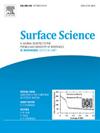常温和常压下NO和CO对Rh(100)表面的影响
IF 1.8
4区 化学
Q3 CHEMISTRY, PHYSICAL
引用次数: 0
摘要
铑用于汽车催化,通过催化NO还原为N2和CO氧化为CO2来减少NO和CO的排放。催化剂中的铑纳米颗粒暴露在NO和CO的高压下,导致催化剂的解体和烧结。为了设计更稳定的催化剂,必须了解高压NO和CO对铑的影响。因此,我们利用扫描隧道显微镜研究了在NO和CO的大气压下,CO还原NO最活跃的Rh(100)表面。原子热力学、低能电子衍射和俄歇电子能谱被用来了解表面吸附物的行为。我们观察到在高CO压力下铑岛的形成和台阶边缘的粗化。在相同的NO压力下不会发生粗化,并且当同时加入NO和CO时,即使在相同的CO分压下,粗化也不那么严重。原子热力学表明,NO可能通过阻断吸附位点、阻止羰基形成和减少表面粗化来抑制CO的吸附。本文章由计算机程序翻译,如有差异,请以英文原文为准。

The effect of NO and CO on the Rh(100) surface at room temperature and atmospheric pressure
Rhodium is used in automotive catalysis to reduce NO and CO emission by catalyzing the reduction of NO to N and the oxidation of CO to CO. Rhodium nanoparticles in the catalyst are exposed to high pressures of NO and CO, which leads to disintegration and sintering of the catalyst. To design more stable catalysts, the effects of high pressures of NO and CO on rhodium must be understood. Therefore, we studied the Rh(100) surface, which is most active for NO reduction by CO, at atmospheric pressures of NO and CO with scanning tunneling microscopy. Atomistic thermodynamics, low-energy electron diffraction, and Auger electron spectroscopy were used to understand the behavior of adsorbates on the surface. We observe the formation of rhodium islands and roughening of the step edges at high CO pressures. Roughening does not occur at the same pressures of NO, and is also less severe when co-dosing NO and CO, even at identical CO partial pressures. Atomistic thermodynamics shows that NO likely inhibits CO adsorption by blocking adsorption sites, preventing carbonyl formation, and decreasing surface roughening.
求助全文
通过发布文献求助,成功后即可免费获取论文全文。
去求助
来源期刊

Surface Science
化学-物理:凝聚态物理
CiteScore
3.30
自引率
5.30%
发文量
137
审稿时长
25 days
期刊介绍:
Surface Science is devoted to elucidating the fundamental aspects of chemistry and physics occurring at a wide range of surfaces and interfaces and to disseminating this knowledge fast. The journal welcomes a broad spectrum of topics, including but not limited to:
• model systems (e.g. in Ultra High Vacuum) under well-controlled reactive conditions
• nanoscale science and engineering, including manipulation of matter at the atomic/molecular scale and assembly phenomena
• reactivity of surfaces as related to various applied areas including heterogeneous catalysis, chemistry at electrified interfaces, and semiconductors functionalization
• phenomena at interfaces relevant to energy storage and conversion, and fuels production and utilization
• surface reactivity for environmental protection and pollution remediation
• interactions at surfaces of soft matter, including polymers and biomaterials.
Both experimental and theoretical work, including modeling, is within the scope of the journal. Work published in Surface Science reaches a wide readership, from chemistry and physics to biology and materials science and engineering, providing an excellent forum for cross-fertilization of ideas and broad dissemination of scientific discoveries.
 求助内容:
求助内容: 应助结果提醒方式:
应助结果提醒方式:


